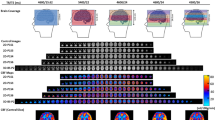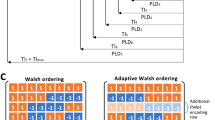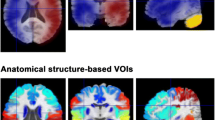Abstract
Objective
Improving the readout for arterial spin labeling with multiple post-labeling delays (multi-PLD ASL) through a flip angle (FA) sweep towards increasing contrast-to-noise ratio for long PLD images.
Methods
Images were acquired from 20 healthy subjects and 14 patients with severe, asymptomatic carotid artery stenosis (ACAS) in a 3T MRI scanner. Multi-PLD ASL images with conventional and proposed (FA sweep) readouts were acquired. For patients, magnetic resonance angiography was used to validate the multi-PLD ASL results. Perfusion values were calculated for brain regions irrigated by the main cerebral arteries and compared by analysis of variance.
Results
For healthy subjects, better contrast was obtained for long PLDs when using the proposed multi-PLD method compared to the conventional. For both methods, no hemispheric difference of perfusion was observed. For patients, the proposed method facilitated the observation of delayed tissue perfusion, which was not visible for long PLD using the conventional multi-PLD ASL.
Conclusion
We successfully assessed brain perfusion of patients with asymptomatic CAS using multi-PLD ASL with FA sweep. We were able to show subtle individual differences. Moreover, prolonged arterial transit time in patients was observed, although they were considered asymptomatic, suggesting that it may not be an adequate term to characterize them.











Similar content being viewed by others
References
Salinet AS, Haunton VJ, Panerai RB, Robinson TG (2013) A systematic review of cerebral hemodynamic responses to neural activation following stroke. J Neurol 260(11):2715–2721
Ostergaard L, Jespersen SN, Engedahl T, Gutierrez Jimenez E, Ashkanian M, Hansen MB, Eskildsen S, Mouridsen K (2015) Capillary dysfunction: its detection and causative role in dementias and stroke. Curr Neurol Neurosci Rep 15(6):37
de Weerd M, Greving JP, Hedblad B, Lorenz MW, Mathiesen EB, O'Leary DH, Rosvall M, Sitzer M, de Borst GJ, Buskens E, Bots ML (2014) Prediction of asymptomatic carotid artery stenosis in the general population: identification of high-risk groups. Stroke 45(8):2366–2371
Detre JA, Leigh JS, Williams DS, Koretsky AP (1992) Perfusion imaging. Magnet Reson Med 23(1):37–45
Williams DS, Detre JA, Leigh JS, Koretsky AP (1992) Magnetic resonance imaging of perfusion using spin inversion of arterial water. Proc Natl Acad Sci USA 89(1):212–216
Lan L, Leng X, Abrigo J, Fang H, Ip VH, Soo YO, Leung TW, Yu SC, WONG LK (2016) Diminished signal intensities distal to intracranial arterial stenosis on time-of-flight MR angiography might indicate delayed cerebral perfusion. Cerebrovasc Dis 42(3–4):232–239
Grubb RL Jr, Derdeyn CP, Videen TO, Carpenter DA, Powers WJ (2016) Relative mean transit time predicts subsequent stroke in symptomatic carotid occlusion. J Stroke Cerebrovasc Dis 25(6):1421–1424
Tsujikawa T, Kimura H, Matsuda T, Fujiwara Y, Isozaki M, Kikuta K, Okazawa H (2016) Arterial transit time mapping obtained by pulsed continuous 3D ASL imaging with multiple post-label delay acquisitions: comparative study with PET-CBF in patients with chronic occlusive cerebrovascular disease. PLoS ONE 11(6):e0156005
Johnston ME, Lu K, Maldjian JA, Jung Y (2015) Multi-TI arterial spin labeling MRI with variable TR and bolus duration for cerebral blood flow and arterial transit time mapping. IEEE Trans Med Imaging 34(6):1392–1402
Lou X, Yu S, Scalzo F, Starkman S, Ali LK, Kim D, Rao NM, Hinman JD, Vespa PM, Jahan R, Tateshima S, Gonzalez NR, Duckwiler GR, Saver JL, Yoo B, Salamon N, Lyu J, Ma L, Wang DJ, Liebeskind DS (2017) Multi-delay ASL can identify leptomeningeal collateral perfusion in endovascular therapy of ischemic stroke. Oncotarget 8(2):2437–2443
Schmid S, Teeuwisse WM, Lu H, van Osch MJ (2015) Time-efficient determination of spin compartments by time-encoded pCASL T2-relaxation-under-spin-tagging and its application in hemodynamic characterization of the cerebral border zones. Neuroimage 123:72–79
Zhang X, Ingo C, Teeuwisse WM, Chen Z, van Osch MJP (2018) Comparison of perfusion signal acquired by arterial spin labeling-prepared intravoxel incoherent motion (IVIM) MRI and conventional IVIM MRI to unravel the origin of the IVIM signal. Magn Reson Med 79(2):723–729
Lawrence KS, Owen D, Wang DJJ (2012) A two-stage approach for measuring vascular water exchange and arterial transit time by diffusion-weighted perfusion MRI. Magnet Reson Med 67(5):1275–1284
Hales PW, Clark CA (2013) Combined arterial spin labeling and diffusion-weighted imaging for noninvasive estimation of capillary volume fraction and permeability-surface product in the human brain. J Cerebr Blood F Met 33(1):67–75
Gunther M, Bock M, Schad LR (2001) Arterial spin labeling in combination with a look-locker sampling strategy: inflow turbo-sampling EPI-FAIR (ITS-FAIR). Magn Reson Med 46(5):974–984
Varela M, Petersen ET, Golay X, Hajnal JV (2015) Cerebral blood flow measurements in infants using look-locker arterial spin labeling. J Magn Reson Imaging 41(6):1591–1600
Francis ST, Bowtell R, Gowland PA (2008) Modeling and optimization of Look-Locker spin labeling for measuring perfusion and transit time changes in activation studies taking into account arterial blood volume. Magn Reson Med 59(2):316–325
van der Plas MCE, Teeuwisse WM, Schmid S, Chappell M, van Osch MJP (2019) High temporal resolution arterial spin labeling MRI with whole-brain coverage by combining time-encoding with Look-Locker and simultaneous multi-slice imaging. Magn Reson Med 81(6):3734–3744
Golay X, Petersen ET, Hui F (2005) Pulsed star labeling of arterial regions (PULSAR): a robust regional perfusion technique for high field imaging. Magn Reson Med 53(1):15–21
von Samson-Himmelstjerna F, Madai VI, Sobesky J, Guenther M (2016) Walsh-ordered hadamard time-encoded pseudocontinuous ASL (WH pCASL). Magn Reson Med 76(6):1814–1824
Wells JA, Lythgoe MF, Gadian DG, Ordidge RJ, Thomas DL (2010) In vivo Hadamard encoded continuous arterial spin labeling (H-CASL). Magn Reson Med 63(4):1111–1118
Buxton RB, Frank LR, Wong EC, Siewert B, Warach S, Edelman RR (1998) A general kinetic model for quantitative perfusion imaging with arterial spin labeling. Magn Reson Med 40(3):383–396
Chappell MA, Groves AR, Whitcher B, Woolrich MW (2009) Variational bayesian inference for a nonlinear forward model. IEEE Trans Signal Process 57(1):223–236
Groves AR, Chappell MA, Woolrich MW (2009) Combined spatial and non-spatial prior for inference on MRI time-series. Neuroimage 45(3):795–809
Jenkinson M, Beckmann CF, Behrens TE, Woolrich MW, Smith SM (2012) Fsl. Neuroimage 62(2):782–790
Pfefferbaum A, Chanraud S, Pitel AL, Shankaranarayanan A, Alsop DC, Rohlfing T, Sullivan EV (2010) Volumetric cerebral perfusion imaging in healthy adults: regional distribution, laterality, and repeatability of pulsed continuous arterial spin labeling (PCASL). Psychiatry Res 182(3):266–273
Qin Q, Huang AJ, Hua J, Desmond JE, Stevens RD, van Zijl PC (2014) Three-dimensional whole-brain perfusion quantification using pseudo-continuous arterial spin labeling MRI at multiple post-labeling delays: accounting for both arterial transit time and impulse response function. NMR Biomed 27(2):116–128
Chen Y, Wang DJ, Detre JA (2012) Comparison of arterial transit times estimated using arterial spin labeling. MAGMA 25(2):135–144
Hara S, Tanaka Y, Ueda Y, Hayashi S, Inaji M, Ishiwata K, Ishii K, Maehara T, Nariai T (2017) Noninvasive evaluation of CBF and perfusion delay of moyamoya disease using arterial spin-labeling MRI with Multiple postlabeling delays: comparison with. AJNR Am J Neuroradiol 38(4):696–702
Haga S, Morioka T, Shimogawa T, Akiyama T, Murao K, Kanazawa Y, Sayama T, Arakawa S (2016) Arterial spin labeling perfusion magnetic resonance image with dual postlabeling delay: a correlative study with acetazolamide loading (123)I-iodoamphetamine Single-Photon emission computed tomography. J Stroke Cerebrovasc Dis 25(1):1–6
Paschoal AM, Leoni RF, Santos AC, Foerster BU, Paiva FF (2015) ASL contrast optimization in multiphase STAR labeling using variable flip angle. In: 21st annual meeting of the organization for human brain mapping, Honolulu, p 1857
Paschoal AM, Leoni RF, Santos AC, Foerster BU, Paiva FF (2017) Improving arterial spin labeling acquisition to reduce the effect of delayed arrival time. In: ISMRM 25th annual meeting & exhibition, Honolulu, p 1496
MacIntosh BJ, Filippini N, Chappell MA, Woolrich MW, Mackay CE, Jezzard P (2010) Assessment of arterial arrival times derived from multiple inversion time pulsed arterial spin labeling MRI. Magn Reson Med 63(3):641–647
MacIntosh BJ, Lindsay AC, Kylintireas I, Kuker W, Günther M, Robson MD, Kennedy J, Choudhury RP, Jezzard P (2010) Multiple inflow pulsed arterial spin-labeling reveals delays in the arterial arrival time in minor stroke and transient ischemic attack. AJNR Am J Neuroradiol 31(10):1892–1894
Wang T, Xiao F, Wu G, Fang J, Sun Z, Feng H, Zhang J, Xu H (2017) Impairments in brain perfusion, metabolites, functional connectivity, and cognition in severe asymptomatic carotid stenosis patients: an integrated MRI study. Neural Plast 2017:8738714
Camargo AP, Silva P, Rodrigues G, Camilo M, Paschoal A, Barreira C, Abud D, Leoni R, Pontes-Neto OM (2018) Cerebral perfusion, functional connectivity and cognitive profile of patients with assymptomatic carotid stenosis. Stroke 49:ATP422
Chen YF, Tang SC, Wu WC, Kao HL, Kuo YS, Yang SC (2017) Alterations of cerebral perfusion in asymptomatic internal carotid artery steno-occlusive disease. Sci Rep 7(1):1841
Xiang J, Zhang T, Yang QW, Liu J, Chen Y, Cui M, Yin ZG, Li L, Wang YJ, Li J, Zhou HD (2013) Carotid artery atherosclerosis is correlated with cognitive impairment in an elderly urban Chinese non-stroke population. J Clin Neurosci 20(11):1571–1575
Wang T, Mei B, Zhang J (2016) Atherosclerotic carotid stenosis and cognitive function. Clin Neurol Neurosurg 146:64–70
Acknowledgements
The authors would like to acknowledge Angela Cristina Pregnolato Giampedro for editing the manuscript for language and style. This work was supported by São Paulo Research Foundation (FAPESP) (Grant # 2013/23740-0), financed in part by the Coordenação de Aperfeiçoamento de Pessoal de Nível Superior—Brasil (CAPES)—Finance Code 001, and by the Conselho Nacional de Desenvolvimento Científico e Tecnológico (CNPq) (Grant # 140110/2016-0).
Author information
Authors and Affiliations
Contributions
AMP contributed to study conception and design, acquisition of data, analysis, and interpretation of data and drafting of the manuscript. RFL contributed to acquisition of data, analysis, and interpretation of data and critical revision. BUF contributed to study conception and design and acquisition of data. ACS contributed to the analysis and interpretation of data. OMPN contributed to the analysis and interpretation of data. FFP contributed to study conception and design, data acquisition, analysis and interpretation of data, and critical revision.
Corresponding author
Ethics declarations
Conflict of interest
On behalf of all the authors, the corresponding author states that there is no conflict of interest.
Ethical approval
Human in vivo data were acquired in accordance with the guidelines set by the ethics committee of the University os São Paulo and after obtaining written informed consent from the subjects.
Additional information
Publisher's Note
Springer Nature remains neutral with regard to jurisdictional claims in published maps and institutional affiliations.
Electronic supplementary material
Below is the link to the electronic supplementary material.
Rights and permissions
About this article
Cite this article
Paschoal, A.M., Leoni, R.F., Foerster, B.U. et al. Contrast optimization in arterial spin labeling with multiple post-labeling delays for cerebrovascular assessment. Magn Reson Mater Phy 34, 119–131 (2021). https://doi.org/10.1007/s10334-020-00883-z
Received:
Revised:
Accepted:
Published:
Issue Date:
DOI: https://doi.org/10.1007/s10334-020-00883-z




